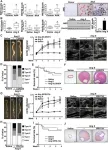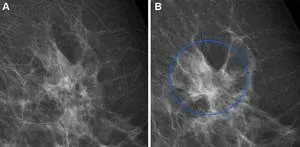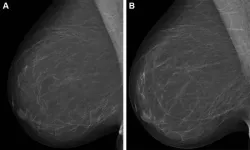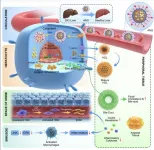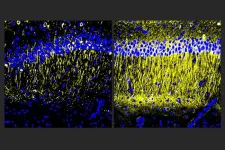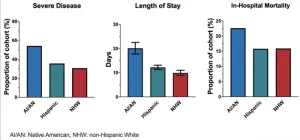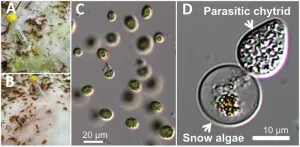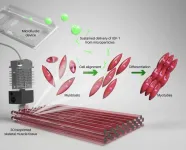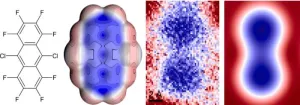(Press-News.org)
Abdominal aortic aneurysm (AAA), a common degenerative vascular disease, particularly afflicts men over the age of 60, with up to 8% affected. Characterized by the abnormal dilation of the abdominal aorta, AAA risks a potentially fatal rupture. Despite increasing research efforts, effective pharmaceutical strategies to curb aneurysm growth remain elusive.
In a study published in the journal of Genes & Diseases, researchers from Sant Pau Hospital Research Institute and Biomedical Research Institute Sant Pau scrutinized the Wnt signaling pathway's deregulation in human abdominal aortic aneurysm (AAA). This investigation revealed marked increases in WNT2 mRNA levels and moderate increments in WNT5A and WNT5B levels in aneurysmal samples as compared to healthy aortas. Further, a considerably higher presence of active β-catenin, the transcriptionally active form, was detected primarily in the inflammatory infiltrate of aneurysmal lesions, suggesting Wnt/β-catenin pathway activation in human AAA. Interestingly, the identified deregulation in Wnt signaling strikingly mirrored the scenario observed in aneurysmal aortas from AngII-infused ApoE−/− mice, a well-established AAA model. Based on these insights, the team hypothesized that the Wnt pathway might be a promising therapeutic target for AAA. Trials were carried out employing LGK974, a potent and specific porcupine inhibitor, and PRI-724, a selective inhibitor of β-catenin/CBP interaction, in AngII-infused ApoE−/− mice. While LGK974 was effective in reducing the vascular expression of the Wnt/β-catenin/TCF signaling target gene Axin2, it did not significantly curtail the progressive enlargement of the aortic diameter induced by AngII. Similarly, although PRI-724 modestly delayed the AngII-induced aortic diameter enlargement, the effect lacked statistical significance. In conclusion, the study underscores the significant role of the Wnt/β-catenin pathway in human and experimental AAA, but the therapeutic interventions tested, LGK974 and PRI-724, showed limited efficacy, with the exception of a minor reduction in aneurysm severity attributed to PRI-724.
The study underlines the multifaceted nature of AAA and the pressing need for efficacious treatments, signaling the potential for innovative avenues of intervention. This could potentially pave the way for groundbreaking therapeutic strategies to manage AAA. The researchers maintain that while the specific Wnt inhibitors tested may not have yielded significant benefits, the quest for alternative targets within this pathway could bear promising results for the future treatment of AAA.
###
References
DOI
10.1016/j.gendis.2022.05.017
Funding information
Instituto de Salud Carlos III (ISCIII) (PI21/01048, PI20/01649), the European Regional Development Fund (ERDF-FEDER, a way to build Europe), Ministerio de Ciencia e Innovación (RTI2018-094727-B-100), AGAUR (2017-SGR-00333, 2017-SGR-1807) Consejo Superior de Investigaciones Científicas (2021AEP073). L. P. is supported by a PFIS contract (ISCIII), C.B–S by a FPU fellowship,A.R.-S. and M.G. were funded by the Miguel Servet Program.
About Genes & Diseases
Genes & Diseases is a journal for molecular and translational medicine. The journal primarily focuses on publishing investigations on the molecular bases and experimental therapeutics of human diseases. Publication formats include full length research article, review article, short communication, correspondence, perspectives, commentary, views on news, and research watch.
END
OAK BROOK, Ill. – Combining artificial intelligence (AI) systems for short- and long-term breast cancer risk results in an improved cancer risk assessment, according to a study published in Radiology, a journal of the Radiological Society of North America (RSNA).
Most breast cancer screening programs take a one-size-fits-all approach and follow the same protocols when it comes to determining a woman’s lifetime risk of developing breast cancer. Using mammography-based deep learning models may improve the accuracy of breast cancer risk assessment and can also lead to earlier ...
An anti-obesity drug can be delivered selectively to the liver using a nanogel-based carrier, according to a study. Synthetic thyroid hormone mimics are promising treatments for metabolic diseases including metabolic dysfunction-associated steatohepatitis (MASH), high cholesterol, type 2 diabetes, and inflammatory liver disease; however, the molecules are not highly bioavailable or potent, which are necessary to see significant weight loss. S. Thayumanavan and colleagues designed a nanogel-based carrier with anionic moieties on the surface ...
Digital Science, a technology company serving stakeholders across the research ecosystem, is pleased to announce that Australia’s Nuclear Science and Technology Organisation (ANSTO) has chosen Symplectic Elements from Digital Science’s flagship products to advance awareness of its world-class research.
ANSTO is the home to some of Australia’s most significant national infrastructure for research. Thousands of scientists from industry and academia benefit from gaining access to ANSTO’s ...
Though drug developers have achieved some progress in treating Alzheimer’s disease with medicines that reduce amyloid-beta protein, other problems of the disease including inflammation, continue unchecked. In a new study, scientists at The Picower Institute for Learning and Memory at MIT describe a candidate drug that in human cell cultures and Alzheimer’s mouse models reduced inflammation and improved memory.
The target of the new “A11” molecule is a genetic transcription factor called PU.1. Prior research has shown that amid Alzheimer’s disease, PU.1 ...
A study of COVID-19 patients at a New Mexico hospital finds that the virus hit American Indian patients particularly hard—even though Native American patients had fewer other illnesses or conditions than non-native patients. Douglas Perkins and colleagues analyzed data on 475 patients with COVID-19 infections from the University of New Mexico Hospital. The sample was 30.7% Native American, 47% Hispanic, and 18.5% non-Hispanic White. At admission, Native American patients were younger, more likely to need ...
SAN ANTONIO — August 29, 2023 —Novel Southwest Research Institute-developed direction-finding technology has won a prestigious R&D 100 Award. R&D World Magazine has recognized SwRI’s Wideband Conformal Continuous-Slot Antenna Array as one of the 100 most significant innovations for 2023.
“Southwest Research Institute strives to uncover innovative solutions to complex problems,” said SwRI President and CEO Adam L. Hamilton, P.E. “I am very proud of the work SwRI does and pleased to know this technology, which will provide significant support to naval operations, has been recognized as one of the most important innovations ...
SAN ANTONIO (Aug. 29, 2023) – A DNA-based vaccine is very effective at protecting against COVID-19, according to a joint preclinical study by Scancell Ltd and Texas Biomedical Research Institute (Texas Biomed) recently published in the Journal of Biotechnology and Biomedicine.
Unlike the Pfizer and Moderna COVID-19 vaccines that use messenger RNA (mRNA) to cue the immune system to produce antibodies, this vaccine platform uses sections of viral DNA to achieve a similar result.
“There is always a need to develop new, or improve on existing vaccines to ensure we have effective tools to counter emerging variants,” says Texas Biomed Innovation ...
The microbial communities found in glacier and snowpack ecosystems are an essential part of cold weather environments. Chytrids, a group of fungi that include well-known frog pathogens, are often found in abundance in these ecosystems, but culturing these organisms and learning more about their lifecycle, including their relationship to the snow algae found in these environments, has proven challenging.
In a recently published paper, researchers revealed that they were able to analyze chytrid DNA from two alpine snowpack sites in Japan using single-spore PCR.
The paper was published in Frontiers in Microbiology on June 20.
“We have captured the chytrids ...
(LOS ANGELES) – August 29, 2023 - An advancement in 3D bioprinting of native-like skeletal muscle tissues has been made by scientists at the Terasaki Institute for Biomedical Innovation (TIBI). The key to the TIBI scientists’ approach lies in their specially formulated bioink, which contains microparticles engineered for sustained delivery of insulin-like growth factor-1 (IGF-1). As was shown in their recent paper in Macromolecular Bioscience, sustained delivery of IGF-1 enhances the formation of mature skeletal muscle tissue from muscle precursor cells and facilitates their structural alignment. This increases the efficiency of the regenerative process ...
Scientists from the IOCB Prague, the Institute of Physics of the Czech Academy of Sciences, and Palacký University Olomouc, have once again successfully uncovered the mysteries of the world of molecules and atoms. They have experimentally confirmed the correctness of a decades-old theory that assumed a non-uniform distribution of electron density in aromatic molecules. This phenomenon significantly affects the physicochemical properties of molecules and their interactions. This research expands the possibilities for designing new nanomaterials and is the theme of a paper that has just been published in Nature Communications.
The ...
